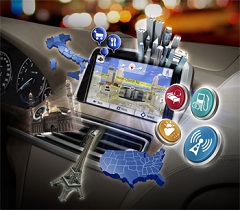Telematics are information and telecommunication products that combine computers and telecommunication services for transferring large amounts of data in vehicles in real-time. Commercial telematics market includes the telematics used by light, medium and heavy commercial vehicles. All major automotive manufacturers across the globe are now concentrating on developing and implementing the Telematics concept into their vehicles. Vehicles manufactured today offer unique connectivity solutions for better monitoring and tracking.
The global commercial telematics market is driven by increased market penetration of smart phones, lowered connectivity cost, availability of high speed internet technologies such as LTE, greater governmental mandate in terms of safety compliance mandates, road infrastructure constraints, and driver monitoring etc.
Do Inquiry For Sample Report @ http://www.custommarketinsights.com/global-commercial-telematics-market-type-applications-end-user-geography-size-share-global-trends-company-profiles-demand-insights-analysis-research-report-opportunities-segmentati-2-/101821#cs_tabs_request_for_sample
Based on type of Telematics, the market is segmented into Automotive Original Equipment Manufacturers (OEM) and Aftermarket. Currently, Aftermarket has relatively high market share compared to Automotive OEM. However, vehicle manufacturing companies forming collaborations with telematics providers would lead to high growth of Automotive OEM segment.
Based on Applications, Telematics market is segmented into Solutions and Services. Solutions include fleet/asset management, infotainment, tele health, insurance telematics, vehicle-to-vehicle (v2v)/ vehicle to infrastructure (v2i), remote alarm and others. Services include design & consulting, deployment & integration and maintenance & training.
Further, Telematics market is segmented based on End User i.e. transportation & logistics, healthcare, insurance, media and entertainment, vehicle manufacturers/dealers, and government agencies. Telematics provides integrated route planning, route execution, driver behavior tracking, and vehicle status with its comprehensive set of services.
Geographically, the market is segmented into, North America, Europe, Asia Pacific and LAMEA. In the years to come, Asia-Pacific should be a prominent market, owing to the rapidly growing number of automobiles sold in the region. The increase in sales is primarily driven by the increasing population, and rising disposal income. LAMEA is also growing with a good pace because of increasing government regulations for the safety & security of drivers and vehicles.
Technology agreements and collaborations are the key strategies adopted by the market players to enhance their market share. For instance, AT&T is working with automotive manufacturers to provide contextual voice controls, which would help to create a safer driving experience. TomTom has launched the online turn-by-turn navigation service for customers, making it feasible to connect over a network.

